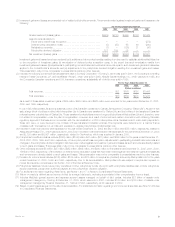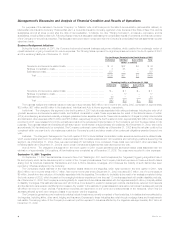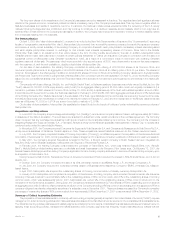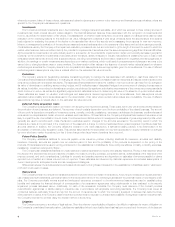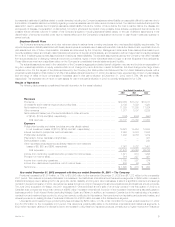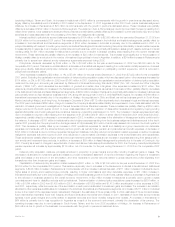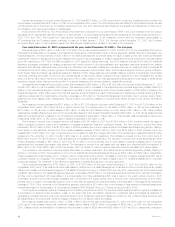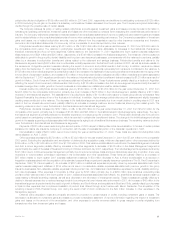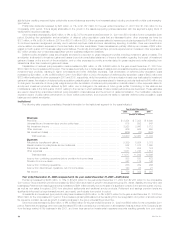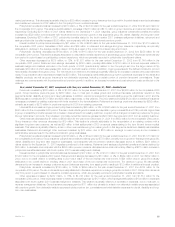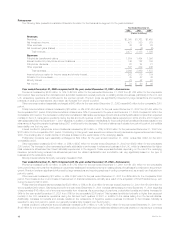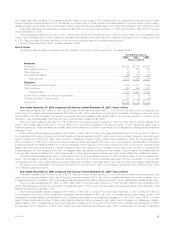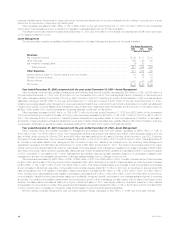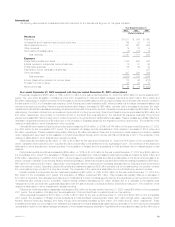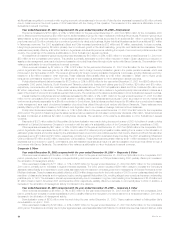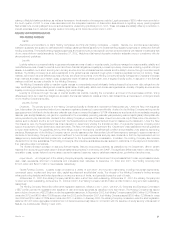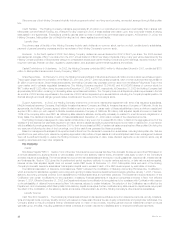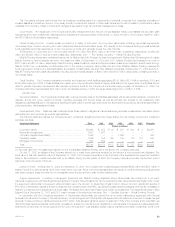MetLife 2002 Annual Report Download - page 17
Download and view the complete annual report
Please find page 17 of the 2002 MetLife annual report below. You can navigate through the pages in the report by either clicking on the pages listed below, or by using the keyword search tool below to find specific information within the annual report.by an increase in fees resulting from growth in annuity deposits. Policy fees from annuity and investment-type products are typically calculated as a
percentage of average separate account assets. Such assets can fluctuate depending on equity market performance. If average separate account asset
levels continue to decline, management expects that policy fees from annuity and investment-type products will continue to be adversely impacted, while
revenues from insurance fees on variable life products would be expected to rise.
Other revenues decreased by $77 million, or 16%, to $418 million for the year ended December 31, 2002 from $495 million for the comparable
2001 period, largely due to lower commission and fee income associated with a volume decline in the broker/dealer and other subsidiaries which is
principally due to the depressed equity markets.
Policyholder benefits and claims decreased by $13 million, or less than 1%, to $5,220 million for the year ended December 31, 2002 from
$5,233 million for the comparable 2001 period. Policyholder benefits and claims for insurance products decreased by $119 million, primarily due to the
impact of the aforementioned reinsurance transaction and the establishment of liabilities for the September 11, 2001 tragedies in the previous year.
Policyholder benefits and claims for annuity and investment-type products increased by $106 million primarily due to an increase in fixed and immediate
annuity liabilities, resulting from business growth and an increase in the liability associated with guaranteed minimum death benefits on variable annuities.
Interest credited to policyholder account balances decreased by $105 million, or 6%, to $1,793 million for the year ended December 31, 2002
compared with $1,898 for the comparable 2001 period. This decrease was primarily due to the establishment of a $118 million policyholder liability with
respect to certain group annuity contracts at New England Financial in 2001. Excluding this policyholder liability, interest credited increased slightly due to
an increase in policyholder account balances which is primarily attributable to sales growth partially offset by declines in interest crediting rates.
Policyholder dividends increased by $3 million, or less than 1%, to $1,770 million for the year ended December 31, 2002 from $1,767 million for the
comparable 2001 period due to the increase in the invested assets supporting the policies associated with this segment’s large block of traditional life
insurance business. This increase is partially offset by the approval by the Company’s Board of Directors in the fourth quarter of 2002 of a reduction in the
dividend scale to reflect the impact of the current low interest rate environment on the asset portfolios supporting these policies.
Other expenses decreased by $118 million, or 4%, to $2,629 million for the year ended December 31, 2002 million from $2,747 for the comparable
2001 period. Excluding the capitalization and amortization of deferred policy acquisition costs, which are discussed below, other expenses decreased by
$118 million, or 4%, to $2,922 million in 2002 from $3,040 million in 2001. Other expenses related to insurance products decreased by $129 million,
which is attributable to continued expense management, reductions in volume-related commission expenses in the broker/dealer and other subsidiaries
and a reduction of $62 million related to business realignment expenses incurred in 2001. These decreases are partially offset by increased pension and
post-retirement benefit expenses over the comparable period. Other expenses related to annuity and investment-type products increased by $11 million.
This increase is commensurate with the rise in sales of new annuity and investment-type products as well as increased pension and post-retirement
benefit expenses. This increase is partially offset by the reduction of $37 million of business realignment expenses incurred in 2001.
Deferred policy acquisition costs are principally amortized in proportion to gross margins or gross profits, including investment gains or losses. The
amortization is allocated to investment gains and losses to provide consolidated statement of income information regarding the impact of investment
gains and losses on the amount of the amortization, and other expenses to provide amounts related to gross margins or profits originating from
transactions other than investment gains and losses.
Capitalization of deferred policy acquisition costs increased by $111 million, or 12%, to $1,037 million for the year ended December 31, 2002 from
$926 million for the comparable 2001 period due to higher sales of annuity and investment-type products, resulting in higher commissions and other
deferrable expenses. Total amortization of deferred policy acquisition costs increased by $100 million, or 15%, to $754 million in 2002 from $654 million
in 2001. Amortization of deferred policy acquisition costs of $744 million and $633 million is allocated to other expenses in 2002 and 2001, respectively,
while the remainder of the amortization in each year is allocated to investment gains and losses. Increases in amortization of deferred policy acquisition
costs allocated to other expenses of $84 million and $27 million related to insurance products and annuity and investment-type products, respectively,
are due to the impact of the depressed equity markets and changes in the estimates of future gross profits. In 2002, estimates of future dividend scales,
future maintenance expenses, future rider margins, and future reinsurance recoveries were revised. In 2001, estimates of future fixed account interest
spreads, future gross margins and profits related to separate accounts and future mortality margins were revised.
Year ended December 31, 2001 compared with the year ended December 31, 2000—Individual
Premiums decreased by $110 million, or 2%, to $4,563 million for the year ended December 31, 2001 from $4,673 million for the comparable 2000
period. Premiums from insurance products declined by $108 million. This decrease is primarily due to declines in traditional life insurance policies, which
reflects a maturing of that business and a continued shift in customer preference from those policies to variable life products. Premiums from annuity
products declined by $2 million, due to lower sales of supplementary contracts with life contingencies and single premium immediate annuity business.
Universal life and investment-type product policy fees increased by $39 million, or 3%, to $1,260 million for the year ended December 31, 2001
from $1,221 million for the comparable 2000 period. Policy fees from insurance products rose by $149 million. This growth is primarily due to increases
in variable life products reflecting a continued shift in customer preferences from traditional life products. Policy fees from annuity and investment-type
products decreased by $110 million, primarily resulting from a lower average separate account asset base. Policy fees from annuity and investment-type
products are typically calculated as a percentage of average assets. Such assets can fluctuate depending on equity market performance. Thus, the
amount of fees can increase or decrease consistent with movements in average separate account balances.
Other revenues decreased by $155 million, or 24%, to $495 million for the year ended December 31, 2001 from $650 million for the comparable
2000 period, primarily due to reduced commission and fee income associated with lower sales in the broker/dealer and other subsidiaries, which was a
result of the equity market downturn. Such commission and fee income can fluctuate consistent with movements in the equity market.
Policyholder benefits and claims increased by $179 million, or 4%, to $5,233 million for the year ended December 31, 2001 from $5,054 million for
the comparable 2000 period. Policyholder benefits and claims for insurance products rose by $192 million primarily due to increases in the liabilities for
future policy benefits commensurate with the aging of the in-force block of business. In addition, increases of $74 million and $24 million in the
policyholder dividend obligation and liabilities and claims associated with the September 11, 2001 tragedies, respectively, contributed to the variance.
Partially offsetting these variances is a reduction in policyholder benefits and claims for annuity and investment-type products due to a decrease in
liabilities for supplemental contracts with life contingencies.
Interest credited to policyholder account balances rose by $218 million, or 13%, to $1,898 million for the year ended December 31, 2001 from
$1,680 million for the comparable 2000 period. Interest on insurance products increased by $165 million, primarily due to the establishment of a
policyholder liability of $118 million with respect to certain group annuity contracts at New England Financial. The remainder of the variance is
predominantly a result of higher average policyholder account balances. Interest on annuity and investment-type products grew by $53 million due to
MetLife, Inc. 13


